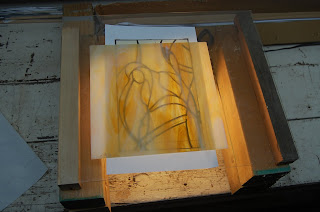Gaia's Pallette
Removing the latex release on the backside of the panel.
Close-up of silica grit and glass. I will vacuum off
all excess grit when the epoxy is cured and the glass
will be totally exposed.
Adding black silica grit before the freshly poured
epoxy hardens. The grit subdues the sheenof the bare
epoxy surface and produces a matte finish. This will
allow for a maximum effect of the vibrant colors.
If, however, the panel is to"live" in the landscape,
then it's advisable to omit the application of the grit.
The grit will accumulate dust, grime and bird
droppings, making it difficult to clean.
Upper Panel (35" X 27")
Latex release is poured between the cut and faceted glass.
The release agent prevents the final epoxy pour from
bonding to the fiber-board and cartoon substrates
as well as from flowing under the slab glass.
Lower Panel (37" X 27")
Glass is resting directly on the building plastic and design cartoon.
Glass is resting directly on the building plastic and design cartoon.
At this intermediate stage, I have secured the wood dams to a fiber-board underlayment and placed the dalles de verre (slab glass), cut with a masonry wet saw, over the design cartoon. I've placed a protective layer of building plastic over the design cartoon in preparation for the next step of pouring an intermediate layer (about 1/16" thick) of latex release agent. The photo is taken before the pouring of the latex release.
The design and the colors are taken directly from Mother Nature and are the result of looking and sensing closely over many fall seasons. The intensity of the dalles de verre (slab glass) medium is my way of imitating and honoring the magnificent colors, shapes and relationships She presents to us year after year.
I enjoy this intermediate stage as the crisp freshly cut slab glass begins to show the strength of the original concept. The faceting of the glass and pouring the epoxy will draw out new intensities and proximity tensions between the glass pieces.
Detail
Spontaneous, informal symmetries appear as if by magic.





































